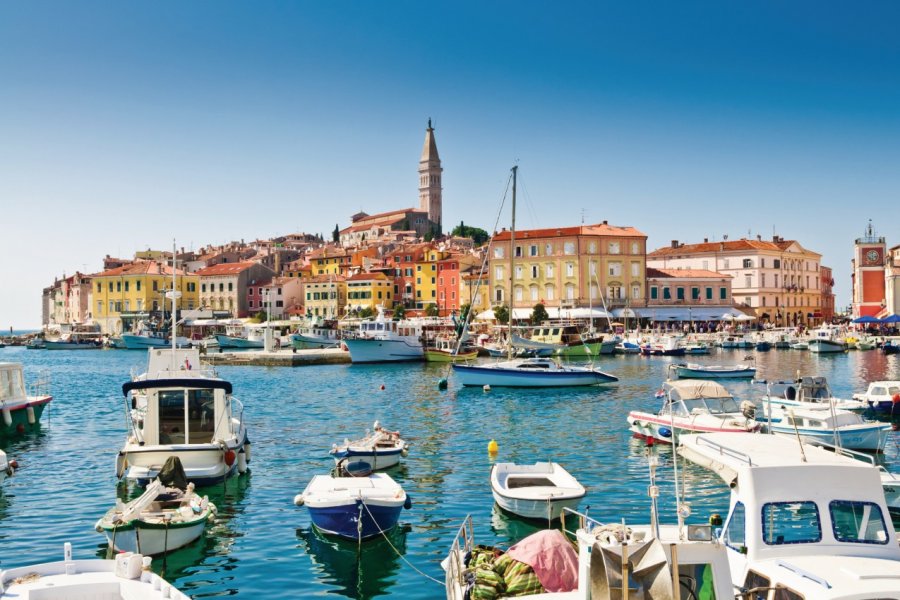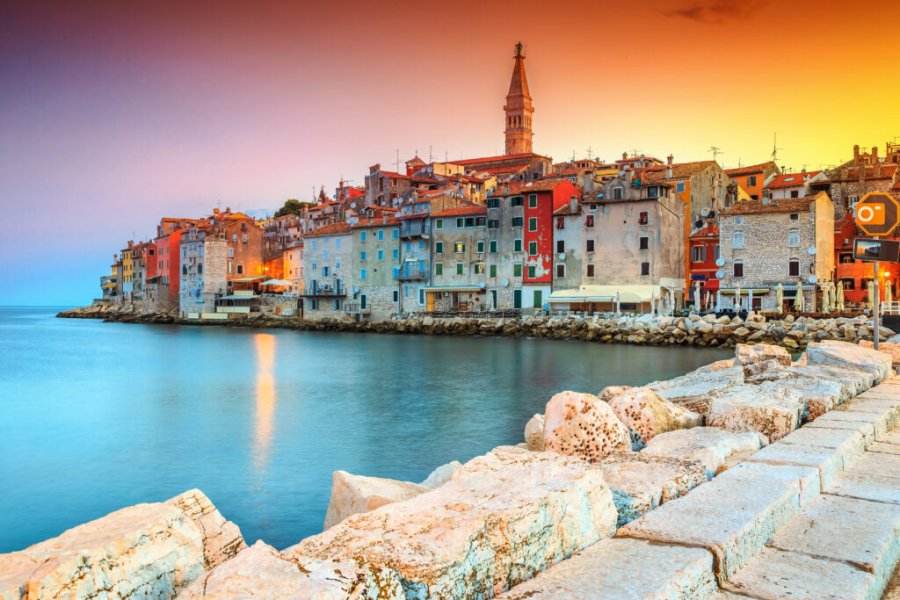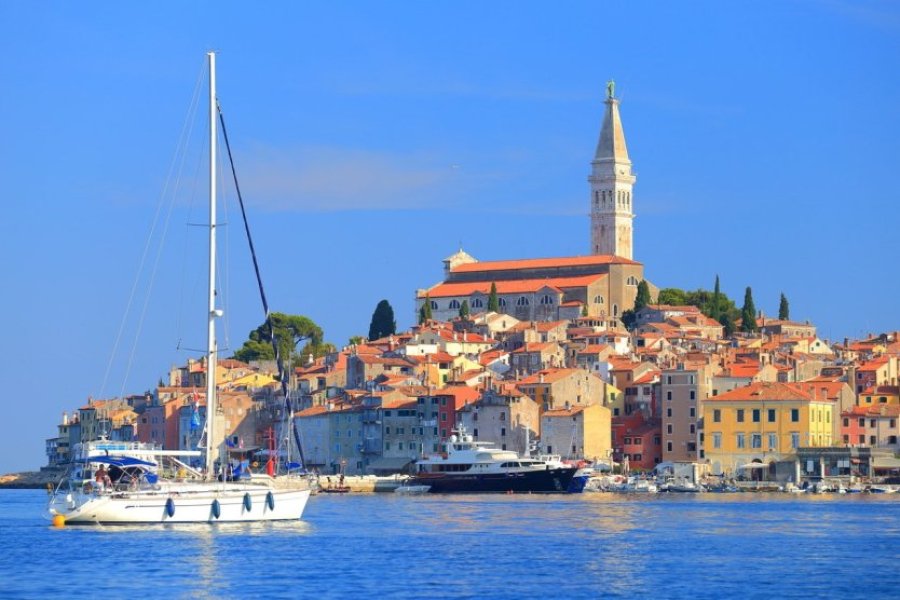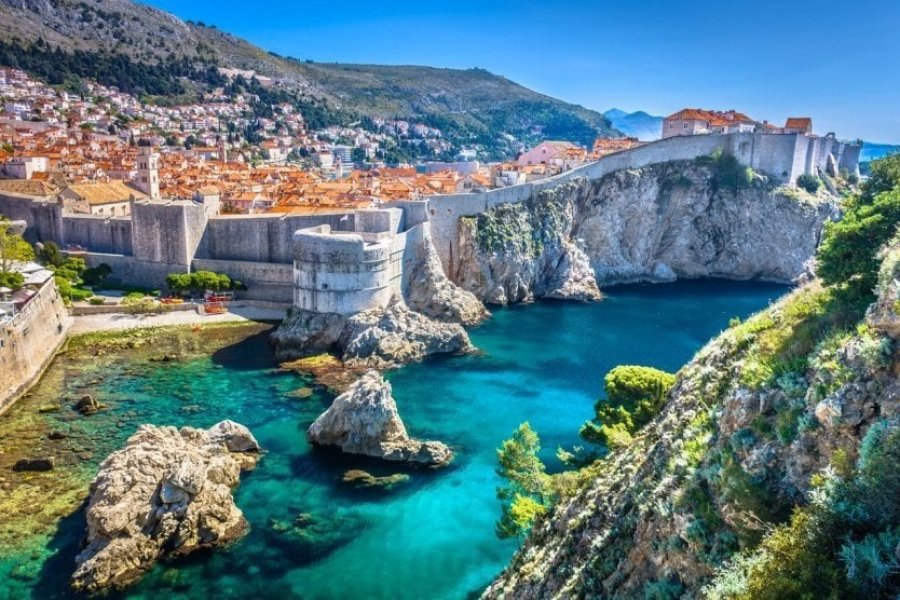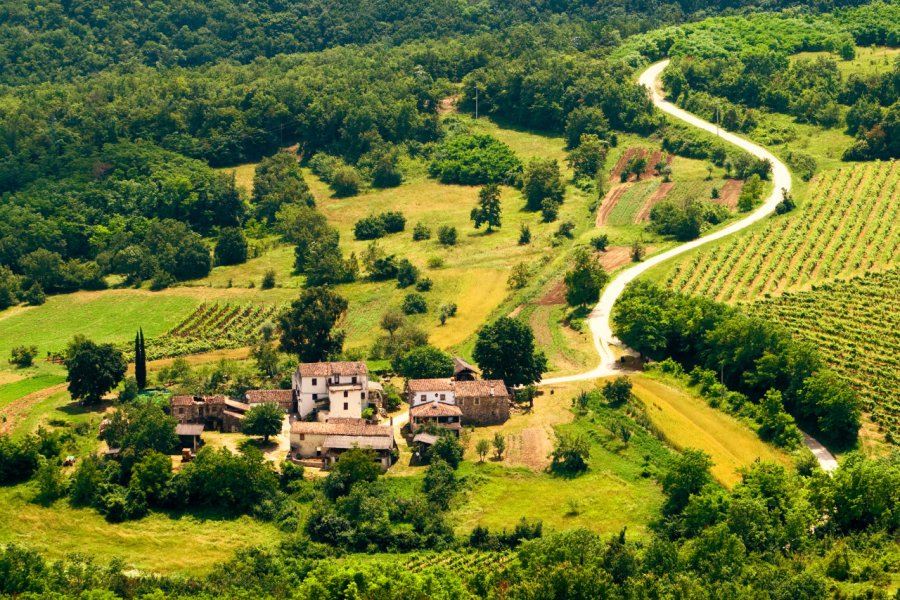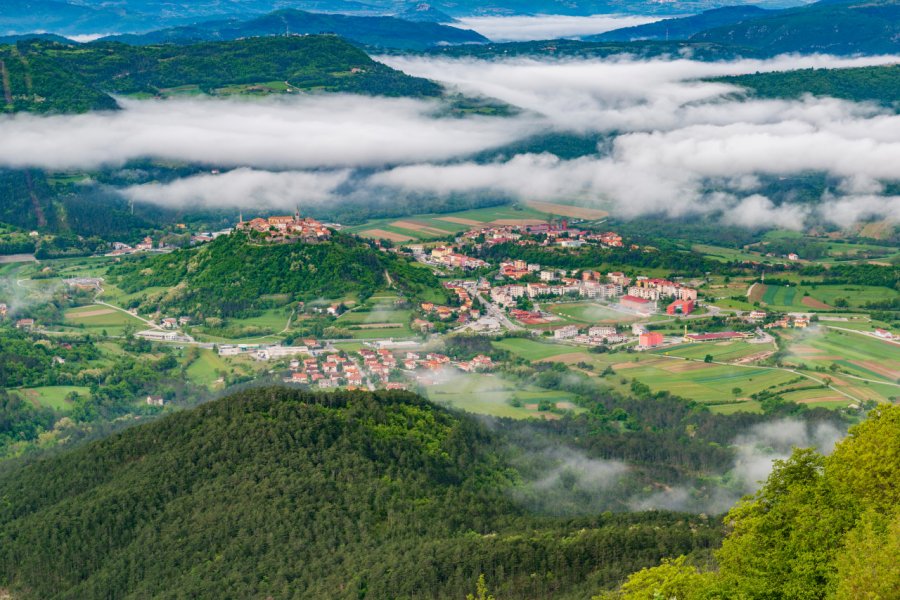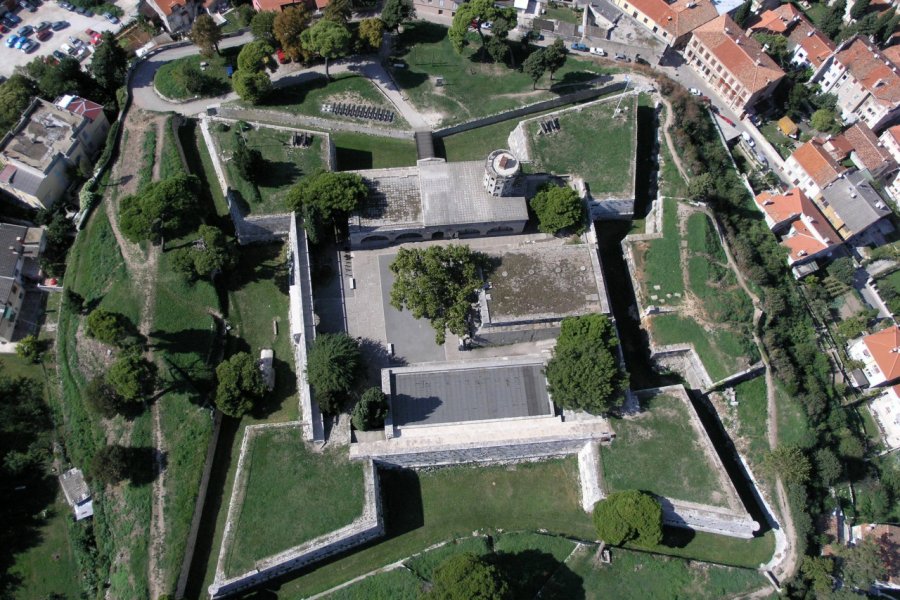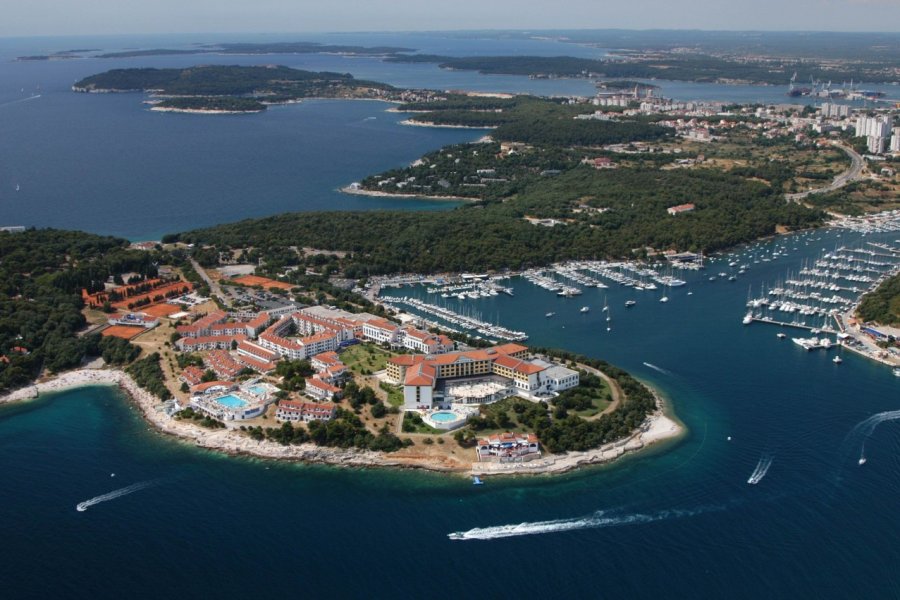Travel guide Istria
Istria is a heart-shaped peninsula in the extreme north-west of Croatia. It is the most popular destination in this enchanting country. Indeed, it captivates with its green hills, picturesque hilltop villages and coastline dotted with idyllic coves and beaches. This pearl of the Adriatic captivates with its astonishing blend of cultures, histories and landscapes. It is one of Europe's most popular destinations. As soon as you arrive, you'll need the Istria Tourist Guide to make sure you don't miss out on any of the local wonders, the best restaurants and the finest accommodation.
Among Istria's must-see treasures , the town of Rovinj stands out with its colorful Mediterranean architecture, picturesque alleyways and breathtaking views of the Adriatic Sea. Poreč, famous for its exceptional historical heritage including the Euphrasian Basilica, and Pula, renowned for its impressive Roman amphitheater, are also must-sees. These towns evoke a Mediterranean atmosphere thanks to their narrow streets, ancient stones and lively harbors.
The region also boasts a rich history dating back to Roman times. But Istria is also an invitation to taste. The region is also known for its olive groves, vineyards and truffle fields. Istrian cuisine promises a gustatory adventure, with truffles, top-quality olive oils and exquisite wines all on the menu. Gourmets are in for a treat! The charm of Istria continues with its hilly hinterland, revealing a palette of vibrant green where perched villages of timeless charm are scattered. For nature lovers, the Brijuni National Park, an archipelago of unspoilt islets, is a little paradise on earth.
Istria is also a destination of choice for wellness. Numerous resorts and thalassotherapy centers offer top-of-the-range services for a rejuvenating vacation. Renowned for its undeniable charm, Istria is a place to discover and rediscover, season after season.
What to see, what to do Istria?
-
Book an activity
-
Customized travel
- The most beautiful cities Istria
When to go Istria ?
The best time to visit Istria is from May to September. During this season, the climate is favorable with pleasant temperatures, ideal for exploring the destination and enjoying its beaches.
From May to June, Istria enjoys sunny weather without being too hot, perfect for hiking and visiting historical sites. In June, you'll have the opportunity to take part in Croatia's Animafest animation film festival, which takes place in the region.
July and August are the hottest months, and the high tourist season is in full swing. Accommodation prices are higher, but this is also the period when many cultural and musical events, such as the Pula Film Festival, take place. If you prefer a quieter holiday with fewer tourists, avoid these months.
The best time to visit Istria if you're looking for peace and quiet is autumn. In September and October, the weather is still mild, and the summer crowds are gone. It's also the ideal time for truffle lovers, as it's harvest season.
From November to April, Istria is in the low season. Temperatures are cooler, and some establishments are closed. However, if you want to experience Istria without the tourist crowds, this is a time to consider. In December, don't miss Istria's Christmas markets, when the region lights up with festivities.
When to go to Istria? It all depends on what you're looking for in terms of climate, budget and activities. Nevertheless, each season offers a unique experience in this enchanting destination.
Suggested addresses Istria
Travel Istria
-
Find a hotel
-
Car Rental
-
International e-SIM package
-
Find a local agency
Around Istria, the reasonable distances between each border, some 50 kilometres, make it possible to make incursions into several countries without major detours. To the north, from Zagreb, there are Hungary, Austria, Slovenia and Italy. To the east, Serbia, to the south, Bosnia-Herzegovina and Montenegro. These border territories with striking similarities all have their own identity. For Croatian, Slovenian and Italian Istria, there is a choice, whether one comes from Zagreb, Ljubljana, Venice or Trieste.
It is also a destination in its own right in Croatia with its cultural peculiarities. Easily accessible from France by road, by air (airports of Pula, Rijeka, Venice) or by boat via Italy, Istria alone can be the subject of a stay of a week or more, to land in one of the wellness establishments along the coast.
Find unique Stay Offers with our Partners
How to go Istria
How to go alone
Solo travel in Istria : what else? For a globetrotter, it's a panacea! Before you leave, learn a few Croatian words to facilitate your interactions:
Hvala: thank you;
Dobar dan : good morning;
Gdje je...?: where is...? ;
Etc.
For accommodation, opt for sobe (for an authentic experience. When you're on the move, the bus network is efficient for reaching the main towns. Don't forget to try a čevapi (meat skewer) in a konoba (traditional tavern). Istria is full of hiking trails, ideal for getting out and about. Plan your visits carefully, especially in high season, as some sites are overcrowded. Take along a good tourist guide, and keep an open mind!
How to go on a tour
Would you like to travel to Croatia with complete peace of mind? Opt for an organized trip to Istria ! It's the ideal way to discover this Croatian gem. Several specialized agencies offer tours covering the must-see sites:
The historic towns of Pula and Rovinj;
Brijuni National Park;
Or the picturesque Oprtalj hills.
Food lovers can enjoy tours focusing on local truffles, olive oil and malvasia wine. If you're more of a beach and sun person, some packages focus on crystal-clear coastlines and water sports. Before booking, compare offers, check reviews and make sure the itinerary suits your interests. Once you're there, relax and enjoy every moment - your agency will take care of the rest!
How to get around
Sailing through Istria is like moving through a living postcard, with each turn revealing a new visual wonder. Addicted to your independence? Rent a car, it's best! The panoramic roads, especially the coastal road between Rovinj and Pula, offer breathtaking views of the Adriatic Sea. Road signs are generally in Croatian and Italian, making navigation easy.
If you're looking for authenticity, you can opt for the frequent and efficient Pulapromet local buses, which run between hilltop villages like Motovun and Grožnjan and the main towns. Bear in mind that in high season, it's wise to book your tickets in advance.
If you're staying near coastal areas, consider water cabs. From Fazana, for example, boats regularly take you to Brijuni National Park.
The more adventurous can rent a bicikl to explore the hilly roads and well-marked paths. Istria is dotted with vineyards and olive groves, so a break for a tasting is always a good idea. Finally, for short distances into town, Cammeo is one of Istria's most popular cab services.
Featured articles Istria
Discover Istria
It's often said that Istria is Croatia in a nutshell! As much for its natural environment as for its culture. Just like its soft language, which plays with Slavic and Latin consonances, the regional identity is at the center of Italian and Slovenian influences. Today, the region is striving for greater autonomy. Regionalism is active. Climatically, the temperate zones are more continental in the northern pre-Alps and frankly mild along the entire Mediterranean coast, which benefits biodiversity, agriculture, seaside tourism and agro-tourism. Croatia's admirably preserved historical heritage, lively folk arts and traditions, generous gastronomy and dolce vita are just some of the reasons why holidaymakers can easily spend a week or more in Istria without getting bored.
Pictures and images Istria
The 12 keywords Istria
1. #Alphabet

Until the 15th century, Croatians wrote in Glagolitic characters. The modern Latin alphabet has thirty letters. However, some letters differ from our own: đ, š, ž. Furthermore, the letters q, x, y and w do not exist in the Croatian alphabet, nor do any silent letters; all letters are pronounced.
2. #Antiquity

Istria was the first territory of present-day Croatia to be colonized by the Roman Empire. Under Augustus, it became Regio X Venetia et Histria, Italy's 10th administrative region. The region's cultural heritage lives on, especially in Pula, where regular festivities featuring costumes, shows, entertainment and gastronomic events bring the past to life.
3. #Bora
A northerly wind from the Velebit, a large mountain range, which skirts the Dalmatian coast before plunging into the Adriatic Sea. The coastal towns of Istria, Trieste, Pula, Rijeka, etc. are subject to this wind, as is the entire Dalmatian coastline. Refreshing in summer, this violent wind makes you feel like you're losing ten degrees on the thermometer in winter.
4. #Tie
One of the few words that French owes to Croatian(hrvatski). Its origins date back to the Thirty Years' War, when Croatian hussars came to France to support the monarchy, wearing a white scarf on their uniforms. In 1666, the cavalry regiment was given the name Royal-Cravates by Louis XIV, hence the name Croate.
5. #Gastronomija
From the Greek gastro and nomia, knowledge of dishes. It's not an empty word in Istria. On the calendar, many convivial events are dedicated to local foods and recipes: herbs, seasonal fruit and vegetables, mushrooms, truffles, honey, cheese, meat and sausages, fish and seafood, pasta, risotto ravioli, gnocchi.
6. #Istarka

The Croatian flag, in Yugoslavian colors (horizontal stripes of red, white and blue), features the historic coat of arms in the center. The red and white checkerboard is surmounted by five shields forming a crown, symbolizing the five components of the country. Istria's coat of arms is represented by the Istarka goat, with red horns and hooves on a blue background.
7. #Kava
As in Italy, the tradition of coffee is inescapable. Espresso, cappuccino, latte macchiato and instant coffee in a bag are drunk at any time of day. Here we say kava! Even on working days, people take coffee breaks at bars and restaurants close to their place of work. At home, kava can be prepared Oriental-style.
8. #Marenda
Admittedly, the working-class tradition is fading, supplanted by breakfast or brunch, but (non-touristy) bars still display the word in front of their windows. Around 10 or 11 a.m., people bring out their salty snack, a sandwich of charcuterie/cheese or fish, which allows early-morning workers to take a break before lunch (around 1 p.m.).
9. FKK
All along the Croatian coast, on the islands, beaches and coves are dedicated to naturism. The king of England Edward VIII and Wallis Simpson would have launched the fashion. The sign FKK(Freikörperkultur) indicates these protected areas. In Istria there are naturist campsites, like holiday villages in Vrsar, Rovinj, Umag, Poreč and Funtana.
10. #Tourism
Croatian tourism accounts for 20% of the national GDP, which is a major economic activity, and it was in the Istrian-Kvarner region that it all began in the 19th century, with the arrival of the Austro-Hungarian aristocracy. In Opatija, the Villa Angiolina, which was one of the first princely bathing residences, a museum of tourism was opened.
11. #Truffles

In Istrian gastronomy, the truffle is by far the most famous! Near the Slovenian border, in Buje, we are proud to recall that it is here, in the countryside, that a farmer found the biggest in the world: 1.3 kg. Every year, the Truffle Days are dedicated to the mushroom and every good Istrian chef/restaurateur introduces it to the menu.
12. #Olive oil wines
While Istrian olive oils gain in excellence every year, regional wines have long been renowned throughout the country. Among Istria's star grape varieties are malvasia istriana, a dry white, moscato momiano (Momjan muscatel) and red teran, a variety native to Istria. Don't miss the wine and oil route.
You are from here, if...
... In summer, you rent out your house or apartment to tourists and move in with the family.
... At sea, you move pebbles to make a sea urchin-free path through the water.
... You leave your towel on the rocks when you go out to lunch or at the end of the day. There are no thieves at sea!
... You eat your cheese as an appetizer (antipasti) and, in summer, you prefer red wine fresh from the fridge!
... At the start of an excursion on a boat, you drink the shot of rakija offered by the captain.
... You don't get on the bus in your bathing suit, towel over your shoulder.
... You cover your shoulders in churches and monasteries.
... You don't feed the seagulls that rip open public garbage cans.
... You know that the break-up of the former Yugoslavia is a sensitive subject. Some will talk about the war of independence, others about the last war, some will praise Tudjman's memory, others will call him a fascist.

